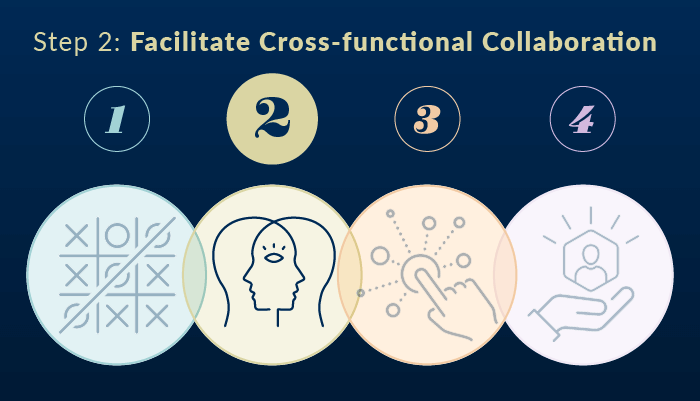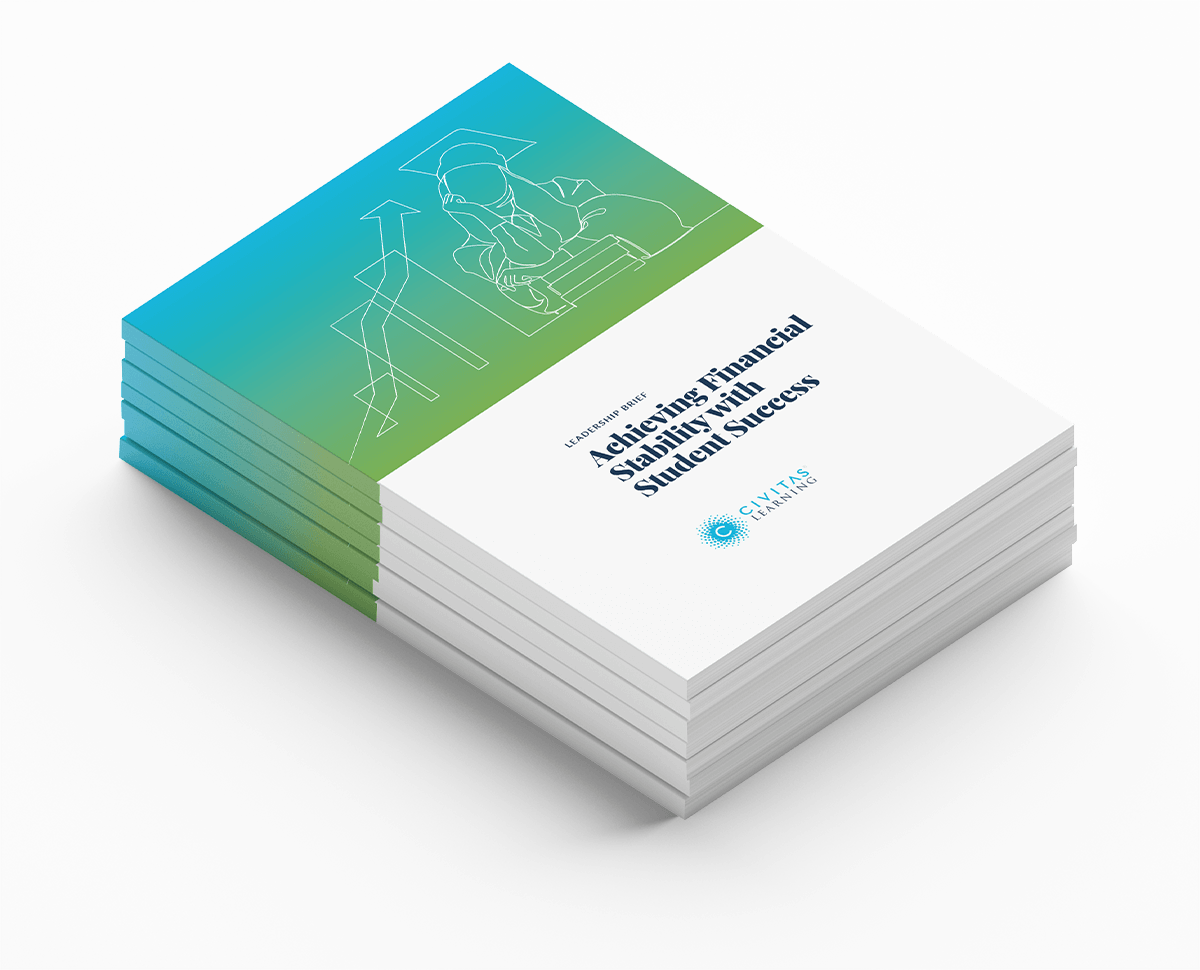
5 Key Elements of a Data-Activated Success Strategy
Share this Post
Once students enroll and begin classes, an institution’s work is far from over. Effective communication, guidance, and resources are foundational to an effective student success strategy. This is particularly important in today’s economic climate, which requires institutions to navigate declines in enrollment and tuition revenue. Every effort matters to keep students enrolled and persisting to graduation.
Tailoring and implementing the right mix of initiatives for each institution is crucial to improving retention and graduation rates. However, some shared practices help provide the support students need to persist to graduation while remaining financially sustainable.
Here are five elements Civitas Learning partner institutions use to improve student outcomes:
1. Unified Understanding of Student Success
Student success doesn’t rest on the shoulders of one department — it’s the responsibility of the entire institution. Ensuring each team understands its role in this work and knows how to take action to improve student outcomes is essential.
This philosophy is at the heart of Northwest Missouri State University’s (Northwest) success. Northwest’s student success model relies on collaboration between faculty, advisors, and student support units, such as diversity and inclusion, the registrar’s office, and the athletics department. This campus-wide effort, backed by the Provost and CFO, ensures that everyone understands the importance of viewing the big picture of a student’s journey to identify and remove any barriers they might face. For instance, if a student has a hold on their account, how is it affecting their ability to register?
Dr. Allison Hoffman, Assistant Vice President of Admissions and Student Success, shares, “Our goal was to bring it all together. If I’m the registrar and the student calls in, I can understand all the touchpoints that student has had.” This approach has yielded impressive results: an 8% improvement in retention from 2016 to 2021, and an overall retention rate of 80% from Fall 2021 to Fall 2022, surpassing their retention goal.
An institution’s organizational structure should support a unified model tailored to the specific needs of its student population. For University of Texas San Antonio (UTSA), they implemented a “hub and spoke” model to break down silos and promote collaboration. This model has a centralized Division of Student Success and individual Student Success Centers within each academic college. Leaders meet regularly to operationalize initiatives and coordinate services since students view the institution as one cohesive entity instead of multiple disconnected touchpoints.

“We’re creating an ecosystem of student support. Many different offices across the university are part of that collective structure. It requires staying connected, using systems in similar ways and having a standard network of care.”
—Dr. Amy Buechler-Steubing,
Assistant Vice Provost, Strategic Initiatives and Learning Innovation, The University of Texas at San Antonio
Having a system that makes it easy for teams to align on what approaches work enables more informed, fiscally-conscious decision-making. It also fuels leaders to dig into what initiatives or courses are generating the strongest return on investment (ROI) so they feel confident they are investing in strategies that matter to student success.
Building a Student Success Model that Supports Students and Generates Revenue
2. Data-Activated Decision Making and Planning
With access to student performance and activity, institutions can proactively identify who needs support and how to help them. Democratizing access to data, rather than restricting it to a select few, transforms student success efforts. Data-activated work needs to occur at all levels: from leaders using data to inform strategic decisions and planning, to frontline staff who leverage insights to provide timely, individualized support, to departmental leaders directing investments toward the most effective resources.
This comprehensive approach has led to successes at Civitas Learning partner institutions like Slippery Rock University and Snow College.
When Slippery Rock University (SRU) noticed a decline in student retention, they needed to pinpoint the exact reasons behind the numbers. Instead of relying on general trends, they used real-time predictions from the Civitas Learning Student Impact Platform to identify specific factors affecting student persistence, such as the cumulative GPA for Exercise Science majors. This enabled SRU to intervene during the term when a student’s GPA dipped below 3.0, providing personalized outreach and resources to help them stay on track.

“We can be very direct about who we’re helping. We have limited resources and must ensure we’re applying those resources to the students who need us the most.”
—Dr. John Rindy,
Associate Vice President for Career and Academic Progress, Slippery Rock University
Understanding what initiatives worked for students at Snow College was essential, as advisors faced caseloads ranging from 500 to 600 students. Personalized support was difficult to achieve when advisors had back-to-back meetings with limited time to assess programs and resources. When Snow College leveraged Civitas Learning’s Administrative and Initiative Analysis solution to determine if all students benefit equally from a one-on-one advising experience, the answer was clear.
While all students benefit from personalized advising services, lower-performing students saw a 20% boost in persistence compared to a 3% lift among high-performing students. This visibility allowed leaders and their teams to refine their approach — offering group advising for high-performing students, and opening up more opportunities for one-on-one advising with lower-performing students. This analysis contributed to a 12% increase in retention from Fall 2022 to Fall 2023.
Updating persistence predictions throughout the semester using ongoing academic and behavioral data provides institutions such as SRU and Snow College with a more accurate and dynamic assessment of student risk. Teams can intervene proactively during the term, rather than relying solely on historical and demographic data. These proactive measures are critical because students’ likelihood of degree completion can vary widely over time due to factors such as economic shifts and personal circumstances. It can also help institutions improve fiscal health by retaining students and tuition dollars that might otherwise be lost.
Why It’s Essential to Use Persistence as a Student Success Metric
3. Strong Collaboration Among Teams
Shared access to student information isn’t possible without input and collaboration from stakeholders across campus. Often, advisors, faculty, and student success team members only see a portion of a student’s profile. With information dispersed across departments and communication gaps between teams, implementing an integrated student success network is challenging.
To get a full picture of a student, it’s important to understand their behavior inside and outside the classroom. This helps teams track their progress, identify any challenges, and avoid repeating the same messages through different channels. At Northwest Missouri State University (Northwest), faculty and staff needed streamlined ways to communicate and access student data in one place. An intuitive tool for faculty to document student notes and share important information, like attendance or engagement level changes, ensures everyone has the shared context needed to support students effectively.
With Civitas Learning’s Advising Analytics and Workflow solution, Northwest’s frontline staff have a complete student view, including alerts, appointment notes, relative LMS engagement, and text and email communications. Since many of today’s students need holistic support to succeed, the real-time visibility offered by this solution is essential.
A collaborative, data-informed approach also reduces redundancy in outreach. When teams coordinate their efforts, students receive consistent communication, strengthening their relationship with the institution.
Lorain County Community College (LCCC) prides itself on being a student-centered institution and carefully considers the frequency and delivery of its outreach. They’ve created an environment where staff regularly discuss student data. Dr. Marisa Vernon White, Vice President of Enrollment Management and Student Services at LCCC, shares that “even on a day-to-day level, leaders and front-line staff are looking at dashboards and reports to quickly move to action, absorb information, grasp the major takeaways, and understand how this impacts their role.”
Align Teams to Deliver Fiscally Sustainable Student Services
4. Connect Teams with Streamlined Workflows
The number of systems administrators, faculty, and staff access daily can be overwhelming, often leading users to neglect them altogether. Leaders strive to find ways to simplify or eliminate steps, but it’s hard to do when teams work independently and store notes in different places.
Connecting teams with a shared view of important student information such as student advising notes, academic history, or actionable analytics like persistence or completion predictions, enhances departments’ efficiencies. It frees up more time for teams to directly engage with students and plan ahead, reducing the time and stress of searching for student information before a meeting. Easy access to actionable student information and streamlined workflows allow teams to sustainably provide holistic support.
The student services team at Northwest Missouri State University (Northwest) depends on this connected view to manage their day and effectively support students. They can review students’ academic history and real-time progress, document their appointments and view previous interactions students have with administrators, the registrar, and career counselors, message via text and email, and manage alerts in one system.

“We’ve always known that holistic advising is the right approach, but the Civitas Learning platform allows us to actually do that, to actually address the whole student and know what’s happening with them in and out of the classroom. We wouldn’t be able to do our work without a system like this.”
—Leslie Abarr-Cuenca,
Director of Student Success, Northwest Missouri State University
Similarly, Lorain County Community College values using one integrated solution to reduce the back and forth of moving between systems. When institutions have too many systems and the advisor has to log in and out and document notes in different places they become too focused on technology, taking away from the student sitting across from you. Strategically connecting systems, like student success analytics, case management systems, and student-centered scheduling reduce tasks and create more room for developing students.
How to Update Your Approach to Academic Advising Caseload Management
5. Continuous Assessment of Initiatives and Curriculum
Institutional challenges like declining enrollment and rising tuition costs push departments to focus on being efficient, effective, and financially sustainable. Leaders need to make a real impact while conserving limited resources. Knowing where to invest limited resources is essential to ensuring long-term sustainability. While initiatives like supplemental instruction and success coaching programs are instrumental for many institutions, knowing what works for your specific student population is groundbreaking.
When programs are underused or highly in demand, and the institution struggles to meet the need, it’s time to step back and evaluate their impact on students. Greenville Technical College (GTC) faced this challenge when its Academic Coaching program experienced a surge in demand due to a growing number of students being referred by other areas on campus.
Using insights from Civitas Learning’s Administrative and Initiative Analysis solution, GTC reviewed outcomes for students who engaged in Academic Coaching compared to a group of similar students who did not participate over the past two months. Within a few hours of uploading their data, they uncovered that Academic Coaching improved student persistence by a significant amount — 8.5 percentage points. The analysis allowed them to drill down and analyze the impact on particular student groups. Students with 1-3 completed terms benefited the most (+10.40 percentage point lift for incoming students and a +13.05 percentage point lift for those with 1-3 terms completed).
In addition to analyzing initiatives, understanding which undergraduate courses significantly impact persistence and graduation rates can remove substantial barriers for students. The influence of just one course can alter a student’s academic journey and chances of graduating.
At Lakeland Community College, retention leaders sought to evaluate their mandatory First Year Experience (FYE) course after early alert trends indicated poor student performance. Utilizing Civitas Learning’s Course Insights solution, they found that students earning a D or F in FYE had only a 3% likelihood of graduating compared to their peers, with 13% of students failing the course over the past decade. From here, the college reevaluated its course design and institutional policies, such as course modality and curriculum, and transitioned FYE to a pass/fail format.
Maximize the Impact of Student Success Initiatives with Regular Efficacy Assessment
—————————-
Achieving student success requires a multifaceted approach tailored to each institution’s unique needs. Institutions can create an environment where students thrive by unifying understanding, leveraging data for decision-making, strengthening collaboration, streamlining workflows, and continuously assessing initiatives. The shared practices highlighted by Civitas Learning partner institutions demonstrate that providing holistic support and using data-activated strategies can significantly improve retention and graduation rates.
Contact us to learn more about what it takes for your institution to build a data-activated student success strategy.








